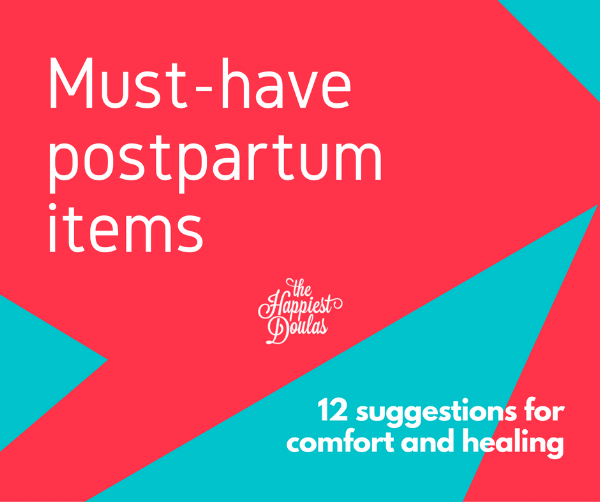Postpartum Expectations and Must-have Items
/
In addition to filling your freezer with nutritious meals, lining up pet sitters, and daily help from family and friends, you'll want to stock up on postpartum supplies to have on hand upon your discharge from your birthing facility. Below are a dozen comfort suggestions to help you prepare for an easier postpartum time and a speedy recovery for both surgical and vaginal deliveries.
This post does NOT include any affiliate links for the below suggested items used for an easy postpartum recovery. We are sharing these links to help you prepare for parenthood. Also, here is our recommended gift registry for infant and breastfeeding gear that you may copy on Babylist to prepare for your baby showers. Happy Shopping!
After care items for a vaginal birth:
Epifoam
If you receive stitches on your perineum, you'll likely receive a numbing spray called Epifoam while in the hospital. If you need more after your return home, ask your doctor if Dermaplast (over the counter) is an acceptable alternative.Sitz baths
This plastic tub is placed directly on the toilet rim (seat up) and you sit on it as it circulates warm water on your bottom via a tube connected to a bag you fill from the sink. This helps clean your bottom, may encourage urination, and will help with healing. Many women find it very comforting. Follow this with an ice pack! (Insert sigh of relief!) Your hospital may offer you a sitz bath or you can find this at your local pharmacy.Peri-bottle
Following the birth of your baby, you will be given a small plastic bottle filled with warm water. Use it to squirt on your bottom as much as necessary to help encourage urination and dilute the sting caused from urine. Once your bladder is empty, squirt your bottom again gently with as much water as necessary to help clean your bottom. Then PAT your bottom dry with hospital wash cloths or toilet paper. Take your bottle home with you or buy a few to keep in each of your bathrooms.
For both type of deliveries:
Doughnut-shaped pillow or wedge (V-shaped) cushion
Called coccydynia or coccygodynia, tailbone pain usually goes away on its own within a few weeks or months after childbirth. To lessen pain while sitting, use a doughnut-shaped pillow or wedge (V-shaped) cushion. Try a dollar store pool tube!Witch hazel or Tuck's pads
Found at your local pharmacy, witch hazel is an over the counter astringent, which can be used to help shrink hemorrhoids. Most commercial bottles of witch hazel contain alcohol so it may sting with direct application. TJ Dickinson's is a brand that sells pure witch hazel. It may take you some time to locate TJ's unless you shop at Whole Foods. (You may want to try the wipes, Tuck's pads, or Preparation H.) If using the liquid, you can make a “padcicle” by soaking a pad with witch hazel and placing it in a clean Ziploc bag then freezing it. Once frozen, remove it and wear it as normal. Many women find this very comforting for their swollen, sore bottoms – especially after a vaginal delivery.Senokot
A gentle vegetable-based laxative called Senokot may be offered to you at the hospital. You can also find it over the counter at your local pharmacy. It is generally well-tolerated (doesn’t cause intestinal cramping) and takes effect within about 12 hours, so it’s usually taken in the evening.Colace
To help with those first few postpartum bowel movements, you may want to try Colace, a stool softener, during the first several days. Once you are eating/drinking somewhat “normally” and soreness has subsided, you may wish to stop taking these medications. Both can be taken on an as-needed basis in the future.Maxi Pads (overnight/heavy flow with wings)
Bleeding for the first 6-8 weeks following delivery is normal. It is called Lochia (LOW-kee-uh). It will begin as very heavy, bright red bleeding that will gradually diminish to a dark red, brown and then to a more yellowish color. During this time period, nothing at all should be introduced to the vagina. Only wear pads, cloth/reusable or disposable, no douching, and no sexual intercourse until the lochia flow has stopped and you have been cleared by your provider."Granny" or Mesh Panties
At the hospital, you will use mesh panties to hold your pad and ice pack. Bring the mesh underwear home with you or have a pair or two at home. If you've had a c-section, try the C-Panty. Here’s a listing of postpartum panties to find the right type for you.Ibuprofen Pain Reliever (Motrin/Advil)
6-800mg of ibuprofen will be brought to you every 6 hours in the hospital, along with some crackers. This medicine will help with cramping, and will also help with inflammation “down below.” Most women find the ibuprofen is enough to manage their pain, but if you are still experiencing a lot of pain, ask your nurse for something else (usually taken in conjunction with the ibuprofen). You will be sent home with a prescription for the 800mg tabs of ibuprofen.Nursing Pads
When you nurse your baby, you will experience what is called a “let down”, which is simply the release of milk from your breasts at the same time. When you hear your baby cry, you may also leak milk and appreciate wearing nursing pads. Both reusable/washable and disposable pads are available for purchase. If you don't plan to breastfeed, you'll still need pads for a bit of time as well as a head of cabbage kept in your fridge.Nipple Cream
In the first few weeks breastfeeding, your nipples may get a bit sore. Nipple cream by Earth Mama Angel Baby or Motherlove will help soothe and heal the affected areas. Alternatively, you could try organic coconut oil.
It Takes A Village
You will need to build your village of support people. It’s important for BOTH parents to seek out support from other parents – not just friends, but other people who have kids and “get it.” Both men and women experience postpartum depression. Read this to be able to recognize the signs of postpartum anxiety and depression.
Find a support group NOW so you know who/where to turn to for help. You can always call your doula or care provider if you need suggestions. We're here for you.
Finally, you may wish to arrange a lesson with an infant care specialist for hands-on guidance on newborn care. Doing so will help ease your transition to parenthood. Best wishes!






